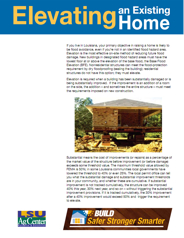 We all know that the best way to keep buildings out of flood waters is to keep them out of areas that flood. The reality for most communities, though, is that homes and other structures are already in areas that flood. What to do then?
We all know that the best way to keep buildings out of flood waters is to keep them out of areas that flood. The reality for most communities, though, is that homes and other structures are already in areas that flood. What to do then?
There are many options, of course. You could somehow acquire and then relocate the structure to a safer area, but sometimes that’s not practical or possible.
If the building can’t be moved from the risky area, the next best thing is to keep it from getting damaged by floods and storms. And one of the best ways to do this is to elevate it above flood waters.
This isn’t a small task, or a simple one, which his why we’re so thrilled with what the folks at Louisiana State University’s AgCenter have done with their new Elevating an Existing Home fact sheet. In eight illustrated pages, they cover when and why you should consider elevating a home, choosing how high to elevate (freeboard, or no freeboard?), how to work with different foundation types, and even how you might pay for it.
Highly recommended, and not just for Louisiana, or even coastal states: this resource should be spread far and wide. Nice work, LSU. And thanks to Pat Skinner for sharing this with us.
Download the PDF: Elevating an Existing Home, a part of LSU’s Build Safer, Stronger, Smarter Program.
UPDATE: Pat has wisely requested that I clarify/emphasize that this fact sheet is designed for Louisiana conditions, and that other states need to consider their own climate, soil types, and state programs. (Thanks, Pat.)
UPDATE 2: Michele Deshotels has sent a link to a good example of elevation at work in Louisiana. It’s a quick and informative read, though, as noted above, keep in mind your local conditions when considering application of any specific techniques in the article. (Thanks, Michele.)